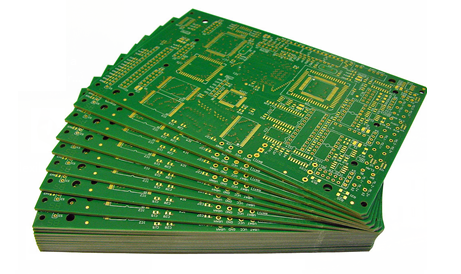Rigid printed circuit boards (PCBs) are the backbone of electronic components, providing a stable platform for mounting and interconnecting electronic elements. Essential for ensuring functionality and reliability, they are the fundamental building blocks in everything from daily-use gadgets to sophisticated industrial machinery.
Composition and Design
Rigid printed circuit boards (PCBs) are the foundational architecture for most electronic devices. They are composed of a substrate, typically made from glass-reinforced epoxy resin materials like FR4, which gives the PCB its rigidity. The conductive layers are usually made of copper, which are etched to form traces that create the circuit’s layout. The number of layers can vary; common configurations include single-sided (one conductive layer), double-sided (two layers), and multi-layered (more than two layers).
The design of rigid PCBs begins with a schematic that maps the circuit. Using computer-aided design (CAD) software, engineers lay out the components and traces on the board. Techniques like through-hole technology (THT) and surface mount technology (SMT) are applied depending on the component types. Designers must consider factors like trace width, spacing, and the placement of vias, which are conductive holes that connect different layers of the board.
Manufacturing Process
The manufacturing process of rigid PCBs follows several key steps:
- Design and Output: Engineers finalize the PCB design and export it in a format suitable for manufacturing.
- Substrate Creation: The chosen substrate material is cut to size.
- Layer Formation: Copper is pre-bonded to the substrate and then etched away to form the circuit pattern.
- Lamination: For multi-layered PCBs, layers are sandwiched and bonded under heat and pressure.
- Drilling: Vias and mounting holes are drilled.
- Plating: The board is plated to add copper to the vias and holes.
- Solder Mask Application: A solder mask is applied to areas that should not get soldered.
- Silkscreen: Component labels and other markings are printed onto the PCB.
- Testing: Boards are tested for functionality and any manufacturing defects.
- Assembly: Components are soldered onto the PCB, often using automated machines.
Quality control is integral throughout the process, with checks like Automated Optical Inspection (AOI) ensuring each stage is completed to standards.

Types of Rigid PCBs
The complexity and application of a Rigid printed circuit board dictate its type. Single-sided PCBs are the simplest, with one layer of copper, and are used in basic electronics. Double-sided PCBs have circuits on both sides, connected by vias, and are used in more complex devices. Multi-layered PCBs, which can have dozens of layers, are used in highly advanced electronic systems where space and functionality are critical.
Specialized rigid PCBs cater to specific needs. High-frequency PCBs are designed to perform well in high-frequency applications (like RF devices), using materials that minimize signal loss. High-TG PCBs are made from materials with a high glass transition temperature, which can withstand higher temperatures without deforming. These specialized PCBs find use in environments where performance and durability under stress are paramount.
Applications of Rigid PCBs
Consumer Electronics
Rigid Printed Circuit Boards (PCBs) are fundamental in consumer electronics, providing the structural backbone for components like smartphones, laptops, and home appliances. Their stability ensures these devices function consistently.
Medical Devices
In medical devices, rigid PCBs are valued for their robustness. They are used in life-saving equipment such as pacemakers and imaging machines, where reliability is non-negotiable.
Automotive Components
The automotive industry relies on rigid PCBs for their longevity and resistance to harsh conditions. They're found in engine control units, GPS systems, and entertainment consoles, ensuring safety and functionality.
Industrial Machinery
Rigid PCBs support industrial applications by withstanding extreme environments. They are integral to manufacturing equipment, automation systems, and robotics, maintaining operations without faltering.
Advantages of Rigid PCBs
Durability and Reliability
Rigid PCBs are preferred for their structural integrity. They are less prone to breakage, which translates to longevity and consistent performance, essential in all fields of their application.
Better Heat Dissipation
These PCBs are designed to manage heat effectively, preventing overheating in electronic devices. This is crucial in high-performance electronics where excess heat can lead to system failures.
Ease of Diagnosis and Repair
When faults occur, rigid PCBs are easier to diagnose and repair compared to their flexible counterparts. Their fixed configurations simplify the location of faults, allowing for quicker maintenance and service.
Trends and Future Developments
Innovations in Rigid PCB Technology
Advancements in materials and manufacturing processes continue to enhance the functionality of rigid PCBs. Innovations such as embedded components and HDI (High-Density Interconnect) technology are pushing the boundaries of what rigid PCBs can achieve.
The Future of Rigid PCBs in Various Industries
Looking ahead, rigid PCBs are set to become even more integral to emerging technologies. They are expected to play a critical role in the advancement of IoT (Internet of Things), automotive electrification, and AI (Artificial Intelligence), where stability and reliability are paramount.
CONCLUSION
Rigid printed circuit boards are the cornerstone of modern electronics, integral to the functionality and miniaturization of devices across industries. The meticulous design and manufacturing process reflect the precision required for these complex components. With a range of types from single-sided to multi-layered and specialized high-TG or high-frequency boards, rigid PCBs offer versatility for any application. As technology advances, the evolution of rigid PCBs will continue to meet the demands of innovation, ensuring they remain at the heart of electronic design and application.










 2023-11-08
2023-11-08
 BEST
BEST

.png)
.png)
.png)
.png)

.png)

